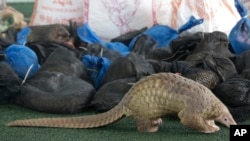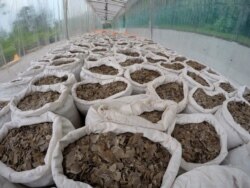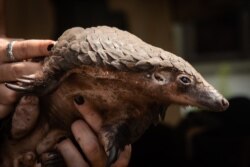The arrival of the new coronavirus pandemic has made something of a wildlife celebrity of a previously not very well-known scaly mammal known as a pangolin.
These cute or creepy looking (depending upon whom you ask) creatures are hunted in sub-Saharan Africa for their scales and meat and illegally trafficked primarily to Southeast Asia.
Several conservation organizations say they are the most heavily trafficked wild mammal on the planet, bringing poachers and smugglers vast amounts of money. Between 2006 and 2015, more than 1 million pangolins are estimated to have been hunted.
The creatures, which vary from the size of a domestic cat to a large dog, have gained notoriety during the coronavirus outbreak, as scientists explore whether the virus originated in the pangolin or whether it could have been a middleman, transmitting it from another wild animal, such as a bat, to humans.
The U.S. Centers for Disease Control and Prevention says the source of the current coronavirus outbreak is not yet known.
Previous outbreaks of severe acute respiratory syndrome (SARS) in 2003 and the Middle East respiratory syndrome (MERS) in 2012, both coronaviruses, had their origins in animals and were transmitted to humans. SARS, for example, began in bats and spread through civet cats to humans.
Thus, the spotlight on the shy, reclusive pangolin, which would rather be left alone to scavenge for ants and termites and sleep all day.
The U.N. Office on Drugs and Crime tracks illegal wildlife activity and released a report this week on trafficking of the pangolin.
“One operation last April seized 25 tons of African pangolin scales — representing an estimated 50,000 dead pangolins — with a market value of some $7 million,” UNODC Executive Director Ghada Waly says in the report. “Between 2014 and 2018, the equivalent of 370,000 pangolins were seized globally.”
There are eight species of the long-snouted creature, whose tongue can be longer than its body. Four species are native to Asia and the other four to Africa. All were placed on the Convention on International Trade in Endangered Species of Wild Fauna and Flora (CITES) protected list in 2016. It is not known how many African pangolins are left in the wild.
The U.N. report details where the pangolins are sourced and how they are smuggled and sold. It found that as Asian supplies of pangolins dried up from overhunting, traffickers turned to Africa to fill demand.
Based on data of seized cargo, UNODC found that starting in 2013, West and Central African nations including Nigeria and Cameroon, followed in 2016 by the Democratic Republic of the Congo, the Central African Republic, Congo (Brazzaville), Gabon and Uganda, all became major suppliers of pangolin scales and meat. More recently, Ivory Coast, Guinea and Liberia have become involved in the illicit trade.
By 2019, Nigeria had become the main exporter of the scaly mammal and Vietnam the primary destination for sale. China, which had imported 99% of pangolin scales between 2013 and 2017, has now turned to seizing illegal shipments.
Local farmers and other community members hunt the creatures. No special equipment is necessary, and UNODC found that hunters can earn from $8 to $13 for a small live pangolin and $25 to $30 for a large one. In Uganda, hunters reported catching as many as 20 per day.
Once caught, the unfortunate pangolin is submerged in hot water or fire to remove its valuable scales. Depending on their size, a pangolin can have up to 1,000 scales. The scales are made of keratin, which is also found in human hair and nails. They will be dried in the sun and later ground into a powder, which is used in Chinese medicine to make a paste believed to help a woman produce breast milk, help blood circulation and ease the pain of arthritis, among other cures. Pangolin meat is also prized as a delicacy in Asian cuisine.
UNODC found that traffickers and routes for moving illicit pangolins mirror those of the illegal ivory trade. As the ivory trade has been in decline, pangolin prices have increased, making it an attractive option for ivory smugglers.
Conservationists hope that the association with the coronavirus will help to end demand for the endangered pangolin.






